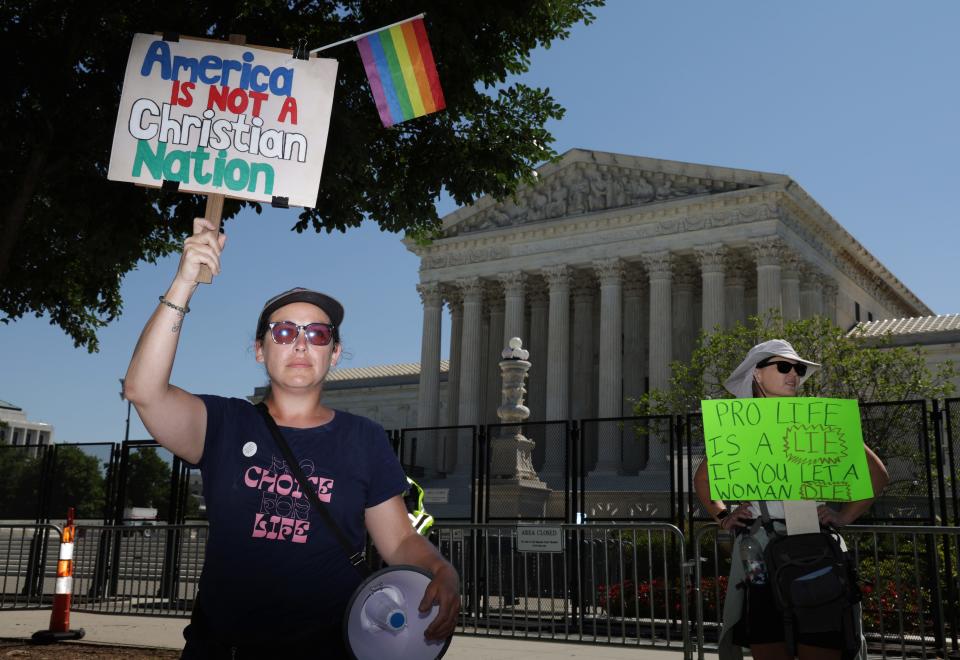Abortion, guns, religion: Breaking down a blockbuster Supreme Court term
WASHINGTON – The Supreme Court wrapped up a historic term Thursday, ending the constitutional right to abortion, expanding access to handguns for millions of Americans and limiting the Biden administration's ability to fight climate change.
How did the court rule on abortion? In the most closely watched case of the 2021-2022 term, five conservative justices voted to overturn Roe v. Wade, the landmark 1973 decision that established a constitutional right to abortion.
What did the Supreme Court say about guns? A 6-3 majority invalidated a New York law that made it difficult for residents to obtain licenses to carry handguns in public. The court also set a new standard under the Second Amendment that may jeopardize other gun laws.
What happened with the "praying coach" and religion? In a series of decisions, the nation's highest court redrew the line separating church and state. In one of those cases, the court said a public school football coach's prayers on the 50-yard line after games is private speech protected by the First Amendment. The decisions seemed to reflect a concern raised by several of the justices that lower courts were giving short shrift to the right to exercise religion.
How did the court rule in its final decisions on climate and immigration? The Supreme Court handed down two major opinions on Thursday. In a blow to the Biden administration, the court said the EPA did not have the authority to regulate power plant emissions. In a win for the White House, the justices said Biden could unwind a controversial, Trump-era immigration policy on migrants.

Here is what we know about the decisions and their implications:
How did the court rule on abortion?
In what was unquestionably the most closely watched case of the year, the Supreme Court ended the constitutional right to abortion it created nearly five decades ago, ruling that Roe v. Wade was wrongly decided and that the right to end a pregnancy wasn’t found in the text of the Constitution nor in the nation’s history.
"Roe was egregiously wrong from the start," Associate Justice Samuel Alito wrote for the majority. "Its reasoning was exceptionally weak, and the decision has had damaging consequences."
Right turn: Supreme Court ends historic term with big shift to the right on abortion, guns
Chief: Roberts wanted to go slow curbing Roe v. Wade. His colleagues were in a hurry.
Graphic: Five crucial sections in the Supreme Court's decision to overturn Roe v. Wade
At issue was a Mississippi law that banned most abortions after 15 weeks of pregnancy – earlier than permitted under earlier Supreme Court decisions. A 6-3 majority upheld the law; in a concurring opinion, Chief Justice John Roberts supported that decision but said he would have stopped short of overturning the 1973 Roe decision.

The outcome shifted the fight over abortion to states, some of which rushed to pass legislation to protect the right to abortion and others that moved quickly to camp down on access to the procedure. Meanwhile, those favoring abortion rights filed a series of lawsuits in conservative states attempting to block abortion bans that took effect.
The five justices in the majority to overturn Roe were:
Clarence Thomas
Samuel Alito
Neil Gorsuch
Brett Kavanaugh
Amy Coney Barrett
The one justice who agreed with upholding Mississippi's law but not overturning Roe:
John Roberts
The three justices who dissented from both those conclusions:
Stephen Breyer
Sonia Sotomayor
Elena Kagan
What did the Supreme Court say about the Second Amendment?

The court struck down a New York law that required state residents to have "proper cause" to carry a handgun in a decision that could make it easier for millions of Americans to arm themselves in public. At least five Democratic-led states – including California, Maryland and New Jersey – have licensing regimes similar to New York's.
Together, those states represent about a quarter of the nation's population.
Ruling: Supreme Court strikes down gun law, making it easier to carry handguns
Breakdown: The Supreme Court just ruled on gun rights. Here's what it means
Impact: Supreme Court's Second Amendment decision demands courts look to history
States can still mandate gun licenses but can't presume the vast majority of residents are not entitled to carry a gun. On a deeper level, the high court set a new standard for reviewing the constitutionality of gun laws that puts a much higher emphasis on what rights were allowed and what regulations on guns where in place when the Second Amendment was adopted in 1791.
"We know of no other constitutional right that an individual may exercise only after demonstrating to government officers some special need," Associate Justice Clarence Thomas wrote of the New York law for a 6-3 majority. "It is not how the Second Amendment works when it comes to public carry for self-defense."
The six justices in the majority who supported invalidating the New York law were:
Clarence Thomas
John Roberts
Samuel Alito
Neil Gorsuch
Brett Kavanaugh
Amy Coney Barrett
The three justices who dissented:
Stephen Breyer
Sonia Sotomayor
Elena Kagan
What happened with the "praying coach" and the court's religion cases?

The court addressed four major religion cases this term and sided with the religious plaintiffs in each of them – continuing a pattern from the last several years.
An 8-1 majority said death row inmates are entitled to physical contact from a spiritual adviser when they are executed. A unanimous court ruled that Boston could not deny a Christian group the ability to raise a flag at City Hall alongside secular organizations that were encouraged to do so. And a 6-3 majority shot down a Maine prohibition on using public money for students to attend schools offering religious instruction.
The school funding case, in particular, may have implications for public education beyond the unusual tuition program at issue in Maine.
But it was the case of a former high school football coach who lost his job for offering prayers at the 50-yard line that captured the most attention. A 6-3 majority said that coach Joseph Kennedy's prayers were a private matter and did not amount to the school district's endorsement of Christianity. Because of that, the court ruled, his prayers were entitled to protection under the First Amendment.
The six justices in the majority who backed Kennedy's prayer:
Clarence Thomas
John Roberts
Samuel Alito
Neil Gorsuch
Brett Kavanaugh
Amy Coney Barrett
The three justices who dissented:
Stephen Breyer
Sonia Sotomayor
Elena Kagan
How did the court rule on climate and immigration?
In its final two decisions of the term, the court handed President Joe Biden one win and one loss.
The court ruled against an Environmental Protection Agency effort to regulate power plant emissions in one of the most significant climate cases decided by the high court in years. Chief Justice John Roberts wrote the opinion for a 6-3 majority, ruling that ,because Congress didn't expressly authorize the EPA's action, the agency had overstepped its bounds.

It wasn't plausible, Roberts said, that Congress intended to give the EPA the power to regulate emissions without saying so in the law. A "decision of such magnitude and consequence rests with Congress itself," he said, or an agency acting with clear consent of lawmakers.
The six justices in the majority who opposed the EPA rule:
John Roberts
Clarence Thomas
Samuel Alito
Neil Gorsuch
Brett Kavanaugh
Amy Coney Barrett
The three justices who dissented:
Stephen Breyer
Sonia Sotomayor
Elena Kagan
In another decision, a 5-4 majority said the Biden administration was within the law when it ended a Trump-era immigration policy that required migrants seeking asylum to remain in Mexico while their cases are reviewed. The decision ended a yearlong legal fight over a policy critics say contributed to a humanitarian crisis on the border.
The five justices in the majority who backed Biden on the immigration policy:
John Roberts
Stephen Breyer
Sonia Sotomayor
Elena Kagan
Brett Kavanaugh
The four justices who dissented:
Samuel Alito
Clarence Thomas
Neil Gorsuch
Amy Coney Barrett
This article originally appeared on USA TODAY: Breaking down the Supreme Court's blockbuster, divisive term

 Yahoo Movies
Yahoo Movies 
